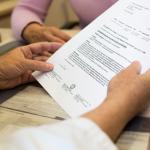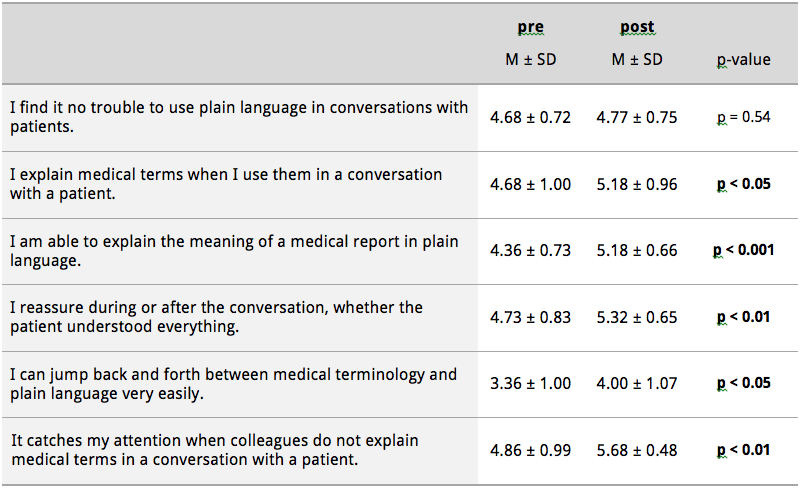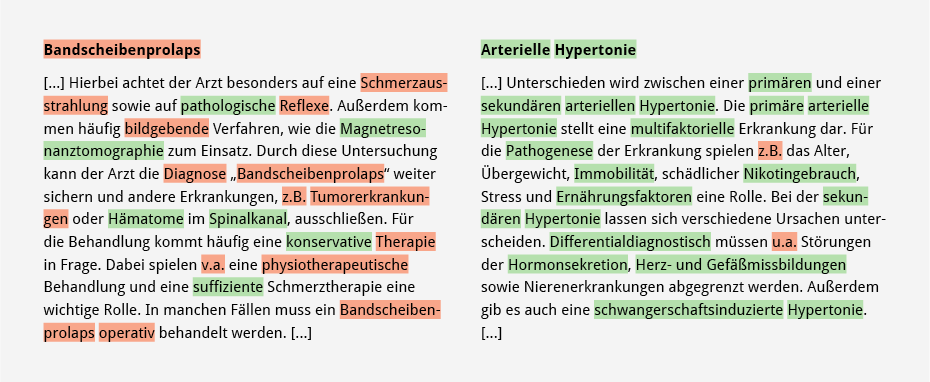


Theme
8AA Communication skills
INSTITUTION
"Was hab’ ich?" gGmbH, Dresden, Germany
III Medical Clinic, University Hospital Hamburg-Eppendorf, Hamburg, Germany
Translating medical documents improves students' awareness for using plain language in patient encounters. Translation exercises should be included in the undergraduate medical curriculum.
Using plain and simple language is a necessary requirement in physicians’ daily practice when communicating with patients. Especially for shared decision making in a consultation with their physician and for giving their consent regarding a procedure patients need to understand medial information fully [1]. However, even though residents reported to use plain language in encounters with patients they used on average two medical jargon terms per minute in standardized patient encounters [2]. In 2011, two medical students from Dresden University, Germany, and a computer scientist founded the nonprofit organization “Was hab’ ich?” gGmbH (“What’s my diagnosis?” LLC), which runs the website https://washabich.de. Patients can submit discharge letters or other medical documents they do not fully understand to this website. German speaking medicals students, who work for this website as volunteers, “translate” the documents into plain German language (see more in the video). We hypothesize that working as a “translator” for this website increases students’ awareness for using plain language in patient encounters.
27 medical students from Hamburg University participated in a newly developed communication course for final year students in the frame of a pilot project. They attended a three-hour seminar including a briefing on patient-centered communication and an introduction to working with the internet platform washabich.de. In the following ten weeks, participants “translated” one medical report every fortnight on this platform receiving feedback by a near-peer supervisor.
Structure of the communication course.
A pre- and post-course assignment consisted of a self-assessment questionnaire on communication skills, an analysis of a medical text with respect to recognizing medical jargon, and the translation of a medical report into plain language. The translations were scored with respect to communicative aspects, e.g. “technical terms are recognized and explained” or “short sentences (< 15 words) are used” and medical correctness.
- Durand MA, Carpenter L, Dolan H, Bravo P, Mann M, Bunn F, Elwyn G. Do interventions designed to support shared decision-making reduce health inequalities? A systematic review and meta-analysis. PLoS One 2014;9:e94670.
- Howard T, Jacobson KL, Kripalani S. Doctor talk: physicians’ use of clear verbal communication. J Health Commun 2013;18:991-1001.
Read more about this pilot study: Bittner A, Jonietz A, Bittner J, Beickert L, Harendza S. Translating medical documents into plain language enhances communication skills in medical students – A pilot study. Patient Educ Couns 2015, http://dx.doi.org/10.1016/j.pec.2015.05.024 [Epub ahead of print].
In the self-assessment, students rated themselves in almost all aspects of patient-centered communication significantly higher after attending the course.
 Pre/post self-assessment of communication skills (n=22), 6-point Likert scale (1: I absolutely disagree to 6: I absolutely agree).
Pre/post self-assessment of communication skills (n=22), 6-point Likert scale (1: I absolutely disagree to 6: I absolutely agree).
In addition, after the course they marked significantly (p<0.001) more medical jargon terms in a short medical text for non-medical readers correctly (87.7% ± 11.2%) than before the course (51.6% ± 19.9%).
Words marked as medical jargon before (left) and after (right) the course: Words shaded in green were marked correctly by more than 70 % of the participants. Words shaded in red were marked correctly by less than 70 % of the participants.
In a written plain language translation of a medical report students scored significantly higher with respect to communicative aspects (39.7 ± 4.1 versus 36.0 ± 6.0 of 50 points; p<0.05) and medical correctness (19.5 ± 2.3 versus 10.5 ± 5.2 of 20 points; p<0.001) at the end of the training.
Translating medical reports into plain language under near-peer supervision is associated with improved communication skills and medical knowledge in undergraduate medical students. Implementing exercises in translating medical reports into plain language in the undergraduate medical curriculum might improve doctor-patient communication. If establishing such a course is not possible, voluntary work on an internet platform like washabich.de might have a similar learning effect for medical students.
We thank the participating medical students for their consent to using the data for this study.


 Send Email
Send Email